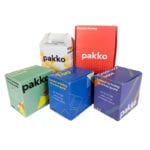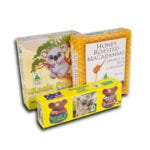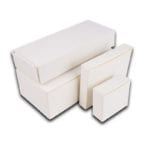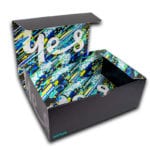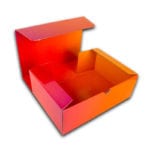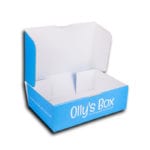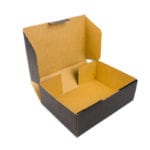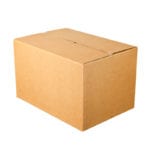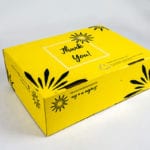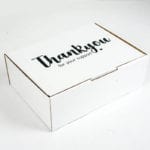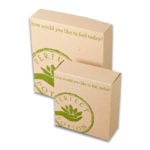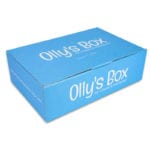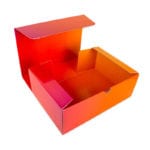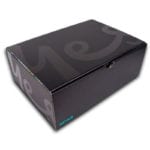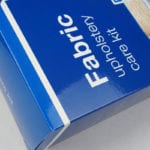Type of Materials We Offer
Art Board - Coated
Coated board is just that. Coated stocks have an extra layer created during manufacturing, this layer makes the paper less porous. Coated stock will be either Gloss (very shiny) or Matte (slightly shiny) and is usually very smooth, it can make colors appear brighter than that of uncoated paper.
Coated stock will have some resistance to moisture, dirt and general wear and tear. Coated paper or board is not the same as laminated or celloglazed paper.
Coated artboard is part of the same family as the Uncoated. (Matching thickness and GSM/weight of the above mentioned stock.)
It is important to note that using coated stock is not a direct substitute for a varnish as it does not have the same final look and feel and or do the same job with resistance to scuffing, print transfer etc.
Both our uncoated and coated boards are printed using CMYK offset printing as well as state of the art digital printing.
Art Board - Uncoated
As you would expect our Uncoated artboard is a part of the same family as the coated. (Matching thickness and GSM/weight of the above mentioned stock.)
The key difference is that we have especially developed this stock to remain uncoated (no gloss, with a slightly textured finish) and still ensure a quality print finish.
Due to the lack of coating this card type is noticeably more absorbent and as such will have a small effect on how the print appears when compared to coated stock.
It is important to note that using uncoated stock is not a direct substitute for a matte varnish as it does not have the same final look and feel.
Both our uncoated and coated boards are printed using CMYK offset printing as well as state of the art digital printing
Corrugated Cardboard
E flute – Our thinnest corrugated stock at 1.5mm and is the first go to when our standard card is not providing the strength or rigidness required for the carton. This could be due to the intended weight being put into the package, or its stacking/handling/transport to its end location.
B flute – This measures at 2.5mm and is most commonly used for shipping and packing cartons as well as more heavy duty boxes or large display stand.
C flute – Measuring at 3.6mm C flute has similar applications to B flute but will provide extra cushioning and protection during transport and handling.
Twin Flute – Like the name suggests this material utilises two layers of corrugated cardboard for an extremely strong final product. Ideal for extremely heavy products being transported. Twin flute measures at 6.5mm thick.
Fibre Board & Box Board
Fibre Board – A multi ply board with brown kraft liners on both sides. We stock Fibre board at thicknesses, 1250um & 1700um. This material is primarily used in house for producing our spare parts box and is oil/grease resistant and extremely durable.
Box Board – This alternative to Fibre Board is an unlined, grey multi ply board made entirely from recycled material. This material is available in thicknesses ranging from 1mm to 2.4mm.
Both materials can be applied in a multitude of ways including partition dividers, rigid backing boards or even a phone stand if you are creative enough. Thinner box board can also be applied in the same way as E flute to create cartons and custom packaging.
Specialty Boards
We endeavour to meet all of our clients needs and as such have quite an extensive range of materials on hand to meet the requirements of your project. Listed below are just some our specialty range boards.
Kraft Board – A natural brown board, its manufacturing process is carbon neutral and includes a minimum of 18% recycled material from pre-consumer waste. Available in thicknesses from 380um to 710mm.
Screen Board – A multi-ply board with a white clay coated surface on each side. Its best suited for display cards and struts, as well as brochure holders and point of sale marketing. Available in thicknesses 1.5mm & 2mm.
Oven safe/ PET board – A Polymer coated board with a clear reverse side coating, this board can withstand temperatures from -40ºC to 220ºC and is well suited for printing. Oven safe board is only available in 400um thickness.
Finishes
Cello Glaze
Cello glazing is a common finishing option in printing, but not everyone knows what it is. Commonly used on business cards, presentation folders and packaging, it offers a high quality finish to your printed jobs.
Available in both gloss and matte options, cello glazing offers a professional look and feel to the finished product by adhering a thin sheet of film using heat and pressure. It has a smooth, silky feeling and also offers added protection and durability to your print job that is very difficult to remove. Not to be confused with spot uv, cello glazing typically covers the entire surface area of a printed product. Often referred to as “cello” there are benefits to both the matte and gloss options. Matte cello is non-reflective and while it offers a silky, smooth finish, it can flatten out the colours in your printed piece.
Mounting
Here at Pakko we are able to mount printed sheets directly on to corrugated cardboard. This allows us to create durable mailer type boxes with vividly coloured and high quality prints.
Spot UV
UV varnish is a technique where varnish is applied to a sheet either as an overall finish or as a spot varnish and then dried using ultra-violet light. It creates a smooth, glossy effect which can really make a striking visual statement on your finished product.
Spot UV illuminates selected text or design components of your print project that gleam and reflect light, giving your printed piece a subtle elegance that is very effective. Using spot UV with unique shapes and patterns can create great contrast and is a simple yet effective finishing solution that will help you stand out from the rest of the crowd. Whether it’s your logo, business name, signature design or contact information, spot UV is a great way to highlight certain areas, or can simply be used as an element in the overall design.
Foiling
Foil printing is a specialty printing process which uses heat, pressure and metallic paper (foil). This is used to create different shiny designs and graphics on various materials. Foil printing gives the focus area an incredible look and is quickly becoming the preferred method of printing in many industries.
